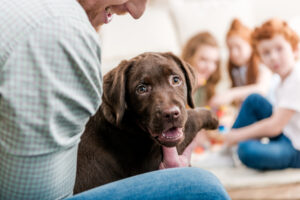






You already know the drill when it comes to protecting yourself from the sun—SPF on your face, your body (including your scalp!).
But have you ever stopped to think about how those same UV rays affect your protection dog?
That’s right—your dog needs sun protection too. Just like us, those rays can seriously damage areas with thin fur or exposed skin.
Think about it: the belly, ears, nose—places where the fur is sparse—are all vulnerable. Veterinarian Dr. Aziza Glass, owner of Personal Touch Veterinary Clinic, highlights that even the groin, eyelids, and mouth are at risk of sunburn. And it doesn’t stop there.
Caring for your protection dog goes beyond applying sunscreen during sunny walks. You’ve got to plan ahead and adjust their care as the seasons change.
Treating July like December? That’s a rookie mistake.
A protection dog’s needs change drastically depending on the time of year, and if you’re not adjusting your approach, you’re missing a key part of their well-being and leaving them unprotected.
Let’s break it down, season by season, with actionable tips to keep your dog healthy, comfortable, and—most importantly—ready to do what they do best: protect you and your family, year-round.
 Let’s kick things off with winter. Cold winds and freezing temperatures can mess with anyone—your dog included.
Let’s kick things off with winter. Cold winds and freezing temperatures can mess with anyone—your dog included.
Frostbite is a real concern, especially for sensitive areas like their earflaps and tail tips. In extreme cold, it’s best to keep them indoors.
But if that’s not an option, you need to stay alert for signs of frostbite, like skin turning white or blue.
You might assume that your dog’s thick coat is enough to shield them, but that’s not always true. Even the toughest dogs can get cold, especially if they’re not used to harsh winter climates.
One of the most important things you can do is keep them warm—without overdoing it….
A well-fitted, functional dog coat can make a huge difference.
Skip the overly padded, flashy ones; your focus should be on something that protects their vital organs while still allowing them to move freely.
After all, they need to be able to do their job.
Just because it’s cold doesn’t mean your dog can’t get dehydrated—especially if they’re spending time outdoors.
Make sure their water bowl stays full, and check regularly to ensure it hasn’t frozen over.
Winter conditions can be brutal on your dog’s feet. Ice, snow, and salt can cause dryness, cracks, and even infections.
Applying a paw balm or wax forms a protective barrier, and frequent checks to remove any ice or salt buildup between their toes will keep them comfortable.
Ever notice how Iditarod sled dogs wear booties? Mushers know that a race can be lost due to paw injuries or abrasions from running on ice.
Your dog may not be running a 1,000-mile race through the Alaskan wilderness, but winter conditions can still do some serious damage.
Investing in dog boots or paw protectors can keep your protection dog’s feet in top shape all season long.
If they’re sleeping indoors, a plush bed and a thick blanket should do the trick. But for outdoor sleepers, you’ve got to step up your game—insulate that kennel like you mean it.
Use pet-safe materials – caulk for gaps, foam board or fiberglass for walls and floor. Just make sure to cover it all with plywood so your dog doesn’t get any bright ideas about chewing on it.
Or, if you’re not the DIY type, grab an outdoor doghouse kit with a removable, washable foam insert. It’s like a sleeping bag for your four-legged guardian.
Either way, your dog stays warm, and you sleep easier knowing they’re comfortable and alert.
Summer is where things can get dangerous fast.
Dogs overheat much quicker than humans, and your protection dog, with its high activity levels, is even more susceptible to heat stroke.

One common mistake I see: walking dogs on hot pavement. If it burns your hand, it’ll fry their paws. Stick to grass or shade.
Always carry water, and take frequent breaks in the shade. Midday sun can turn a regular training session into a heatstroke emergency, and trust me, you don’t want to deal with that.
A great way to keep your dog active and cool at the same time is swimming. It’s a fantastic, low-impact exercise that works their whole body while helping them stay cool.
You can also set up a sprinkler or visit a dog-friendly splash pad.
Many dogs love the water and enjoy chasing jets or splashing around. It’s a fun, easy way for them to stay active while avoiding the heat.
If your dog spends time outside, make sure they have access to both. Place water bowls in various locations, so they can hydrate easily no matter where they roam.
If you’re out and about, always bring a water bottle and a collapsible bowl for your dog. Regular hydration is crucial, even during short trips.
And despite all the precautions, if your dog starts panting heavily, drooling excessively, or showing signs of fatigue, it’s time to call it a day and let them cool off indoors.
Regular brushing removes dead hair and helps regulate their body temperature. If your protection dog has a double coat, resist the urge to shave it off.
That coat acts as insulation, keeping them cool in the summer and warm in the winter. Shaving it might do more harm than good.
As for bathing, aim to bathe your dog every 3-4 weeks in the summer, especially if they’re spending a lot of time outdoors.
Just be sure to use products designed for dogs, and avoid over-bathing, as it can strip their coat of natural oils.
Sulfate-free shampoos are a great option if your dog needs more frequent baths due to their activity levels.
Don’t forget the little things, either:
Fall is a tricky season because it’s all about transition. One day, it’s hot, and the next, you’re dealing with cold winds and rain. Your dog’s care should adapt just as quickly.
Start by adjusting their exercise routine.
The cooler temperatures mean they can be more active for longer periods, but keep an eye on the weather.
If it’s rainy or muddy, those conditions can lead to skin irritations or infections, especially in dogs with longer fur. Clean and dry them off after every walk to prevent issues from cropping up later.
This is also the time to prepare for winter.
Start giving your dog extra joint support supplements if they need them, especially older protection dogs that might feel the cold more in their joints.
You might also want to increase their food intake slightly to help them build up a little extra fat for the colder months ahead.
Parasites are still a concern in the fall, so don’t slack on preventive treatments. Ticks can hang around until the first frost, so regular checks and treatments are still necessary.

Regular vet visits are essential to catch any issues before they become serious.
Keep your protection dog up-to-date on vaccinations, especially if you live in an area prone to parasites or other wildlife-related risks.
Diet is another area that needs attention. A balanced, high-protein diet is crucial for maintaining muscle mass and overall health.
You might need to adjust their portions based on their seasonal activity levels—more active dogs in the winter might need more calories, while less active summer days might require a slight cutback to avoid unnecessary weight gain.
Protection dogs are a serious investment, not just financially but emotionally and in terms of time.
Their health and performance are directly linked to how well you take care of them, especially as the seasons change.
Stay proactive, be adaptable, and your dog will be ready to face whatever the weather throws their way.
You’ve got the blueprint now—step-by-step, season-by-season. You know exactly how to keep your protection dog in peak condition year-round.
The question is, are you going to implement it?
If yes, go give your dog the care they need and implement these tips.
But if you’ve still got questions, or want expert guidance, Vanguard Protection Dogs is here to help. Our team of specialists lives and breathes protection dog care and training.
Here’s what I want you to do:
OR
2. Schedule a consultation with our team of experts.
Don’t wait until your dog’s performance suffers. Don’t let preventable health issues creep in.
Act now.
Your protection dog’s well-being—and their ability to protect you—depends on it.